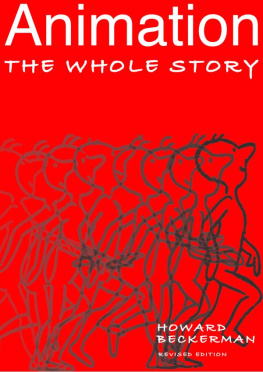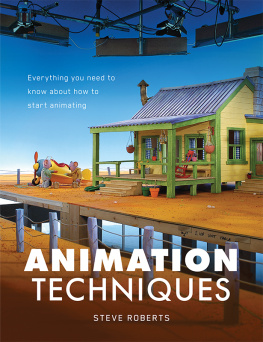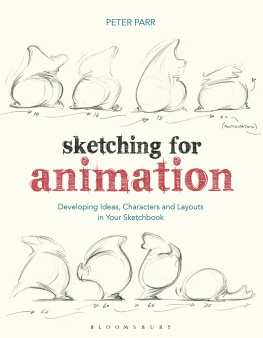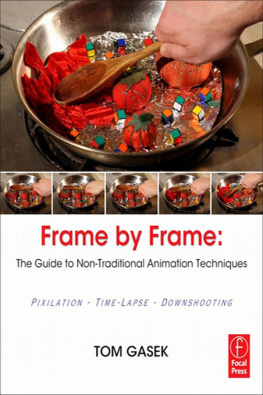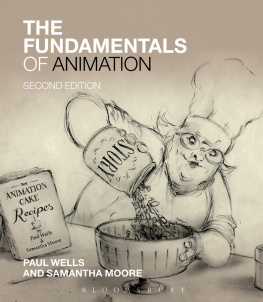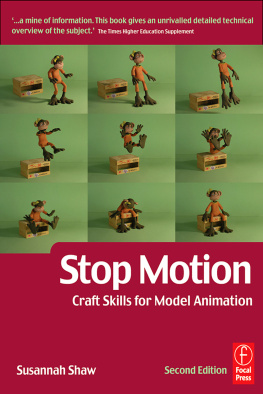
Animation
THE WHOLE STORY
HOWARD BECKERMAN
REVISED EDITION


To the memory of
A. Kip Livingston
Copyright 2003, 2012 by Howard Beckerman
All rights reserved. Copyright under Berne Copyright Convention, Universal Copyright Convention, and Pan American Copyright Convention. No part of this book may be reproduced, stored in a retrieval system, or transmitted in any form, or by any means, electronic, mechanical, photocopying, recording or otherwise, without the express written consent of the publisher, except in the case of brief excerpts in critical reviews or articles. All inquiries should be addressed to Allworth Press, 307 West 36th Street, 11th Floor, New York, NY 10018.
Allworth Press books may be purchased in bulk at special discounts for sales promotion, corporate gifts, fund-raising, or educational purposes. Special editions can also be created to specifications. For details, contact the Special Sales Department, Allworth Press, 307 West 36th Street, 11th Floor, New York, NY 10018 or .
15 14 13 12 11 5 4 3 2 1
Published by Allworth Press, an imprint of Skyhorse Publishing, Inc.
307 West 36th Street, 11th Floor, New York, NY 10018.
Allworth Press is a registered trademark of Skyhorse Publishing, Inc., a Delaware corporation.
Cover design by Derek Bacchus
Cover illustration by Howard Beckerman
Interior design and page composition by Sharp Des!gns, Lansing, MI
eISBN: 978-1-58115-990-5
ISBN: 1-58115-301-5
Library of Congress Cataloging-In-Publication Data
Beckerman, Howard.
Animation : the whole story / Howard Beckerman.
p. cm.
1. Animated filmsTechnique. 2. Animated filmsHistory. I. Title.
NC1765.B37 2003
778.5'347dc22
2003022936
Contents


Acknowledgments
I t was Eli Bauer who suggested I write a book about animation, and it was Kip Livingston who got me to begin in earnest. To Eli for striking the match and to Kip for kindling the fire, I am deeply indebted. Sincere thanks also to my editor Nicole Potter for her patience and guidance in organizing the material found in these pages, and to Derek Bacchus for adding his imaginative and vigorous design skills to the final product. My heartfelt thanks to: Lewis Cohen, Alexander Reyna, Judson Rosebush, Sonya Shannon, and Richard Sneiderman, for clarifying the world of computers for me, and to Sheri Weisz for her insight and advice. I am also deeply indebted to the yeoman efforts of recent animation historians: Joe Adamson, Michael Barrier, Giannalberto Bendazzi, John Canemaker, Leslie Carbaga, Karl Cohen, Donald Crafton, John Culhane, Leonard Maltin, Charles Solomon, and Michael Frierson for their scholarship and observations in bringing animation history to light.
To everyone who patiently gave their time, offered their knowledge, answered my questions, and provided encouragement, I offer my appreciation: Preston Blair, Gerardo Blumenthal, Tad Crawford, Shamus Culhane, George Davis, Ronen Divon, David Ehrlich, Bill Focht, Dave Gantz, John Gati, George Griffin, Lu Guarnier, Kit Hawkins, Bert Hecht, Judi Lynn Lake, Reeves Lehmann, Pat Terry Leahy, Bill Lorenzo, Bob Lyons, Nick Mavroson, Gil Miret, Allan Neuwirth, Silvie Newman, Barbara Nessim, Don Nolan, Tzvika Oren, Don Oriolo, Michael Pinto, Bill Plympton, David Rhodes, Keith Robinson, Fenton Rose, Ronald Schwarz, Miriam Sherry, Adrian Sinnott, Tom Sito, Mara Sneiderman, Cecile Starr, Gunnar Strom, Ed Summer, Beth Tondreau, David Tung, Maureen Volpe, Becky Wilde, Richard Williams, and Amy Zarndt.
Last, but not least, I must thank my wife, Iris, whose artistic talents helped me appreciably and whose abiding faith and sense of humor carried me through the long months of writing and drawing.
Foreword
A nimation is a highly competitive field where each project poses a different style and technique, but where, surprisingly, there is often a lack of creative freedom. Though devoted to fantasy, the animator must confront many realities. No one is more aware of these pitfalls than Howard Beckerman. He had a brilliant career as a writer, director, and animator of the atrical shorts at Paramount Pictures, and when its cartoon unit closed, he opened his own studio to do television commercials and educational films.

Readers will find this book a font of information, and the enthusiastic artist or writer will discover valuable tips on how to succeed in this challenging field.

Shamus Culhane
Animator, director, producer, former director of animation, Paramount Cartoons
Preface
A nimation is a compact medium; its strength is its conciseness. Its like a fruitcake, embracing many wonderful things in one tight space, and, like a fruitcake, it can be very nutty.
The animated picture goes beyond the scope of live-action film and television, there is no other graphic art that so stretches the imagination to get a laugh, display an abstraction, explain a method, or sell a product. It is the ultimate fantasy medium, twisting time and distorting shape. Yet even as it amuses and soothes it also describes and instructs. It is an excellent tool for expressing ideas. It is also fun to do, and you dont have to like fruitcake to do it either.
When I was asked to teach animation after years of working in the field, I found there were few texts available to guide serious students. This book is the result of hundreds of hours of instruction at various levels. As an animator turned teacher, I discovered that students difficulties with drawing, animating, and storytelling were exactly those that I had grappled with when I was starting out. My classes derive from my personal experience in approaching problems, and these encounters have become the basis for this book.

Animators are honest people who take their work seriously, and they know you cant fake it. To get good results takes long, hard, careful effort. To arrive at a point where you know what works and what doesnt requires experience. Traditionally, individuals learned animation by working in one or more studios under the pressure of deadlines, in the presence of intractable artists who were not always forthcoming with their advice.
When I started out in the field I was fortunate to be able to work with veteran animator Irving Spector. Spec, only too happy to take a break from his own tasks, welcomed the opportunity to offer guidance. He was a writer as well as an animator and his work was full of invention. There was little evidence of struggle in his drawings of characters and the worlds they inhabited. I was all of nineteen and he, fifteen years my senior, had put in considerable time at studios in Hollywood and New York. He understood my clashes with the complexities of the medium and that it would take time and patience for me to achieve my goals. His response was, When youre thirty-two, youll know how to do it.
Next page
